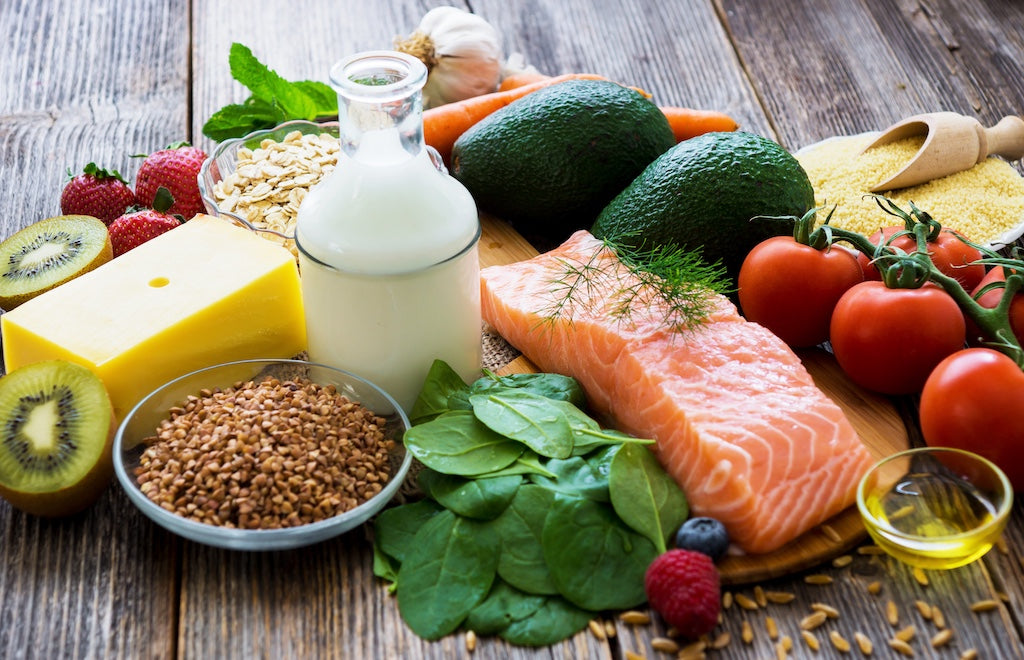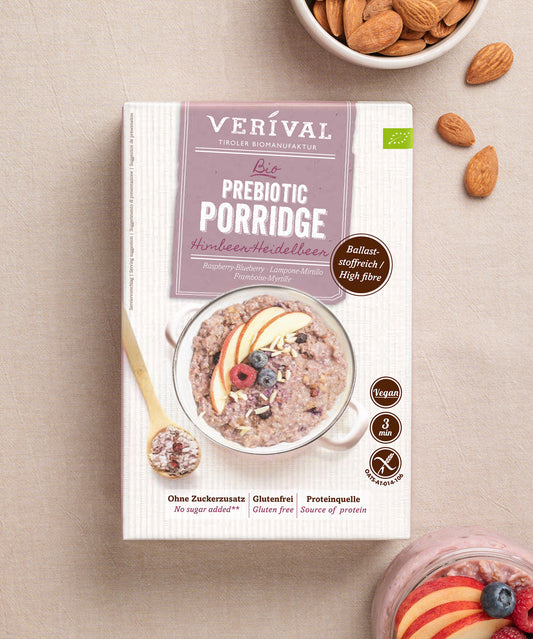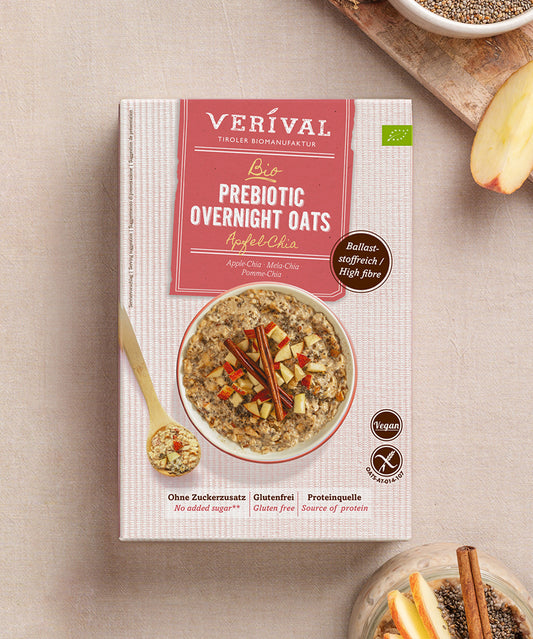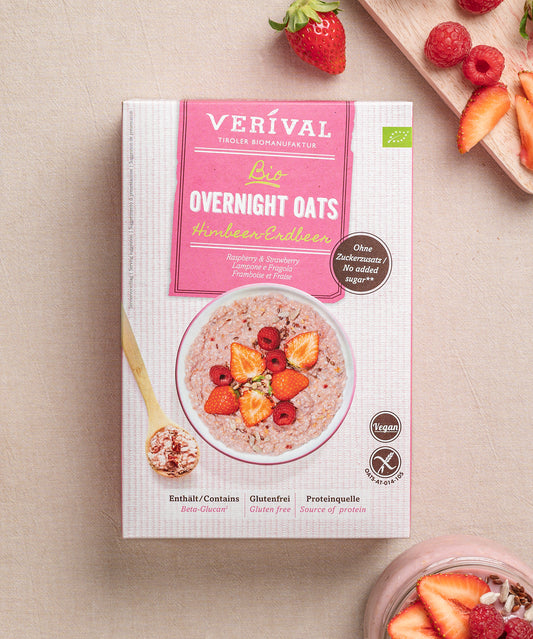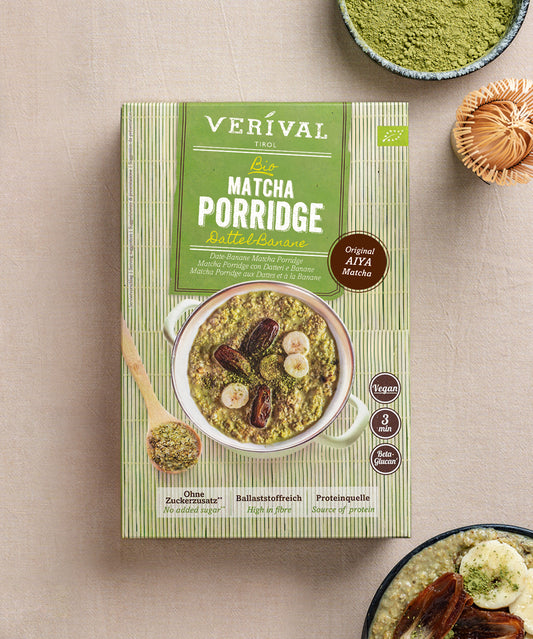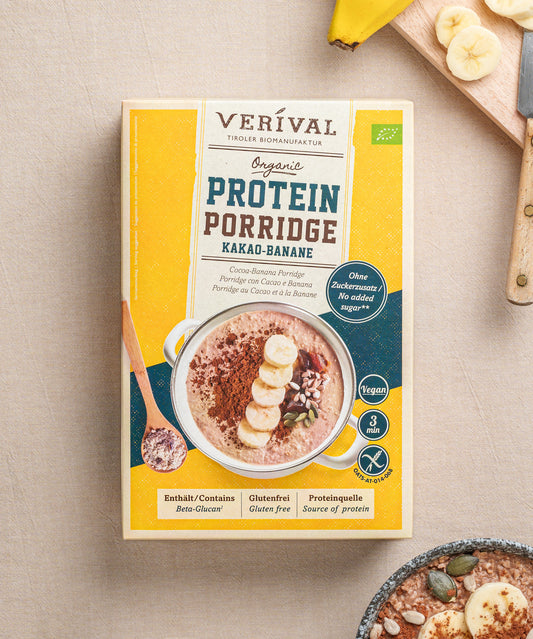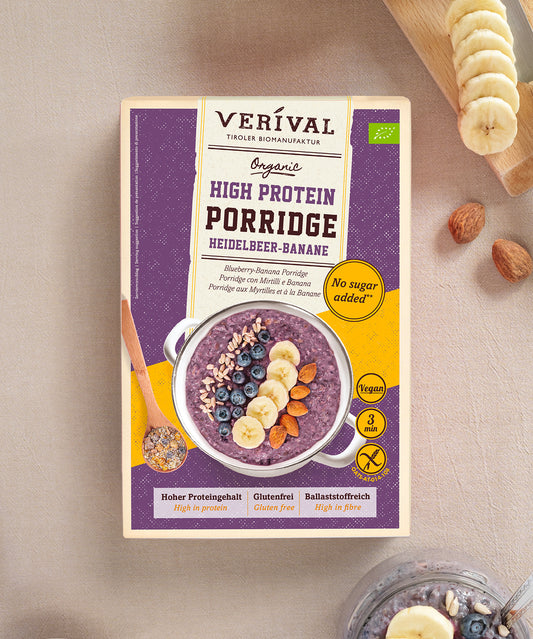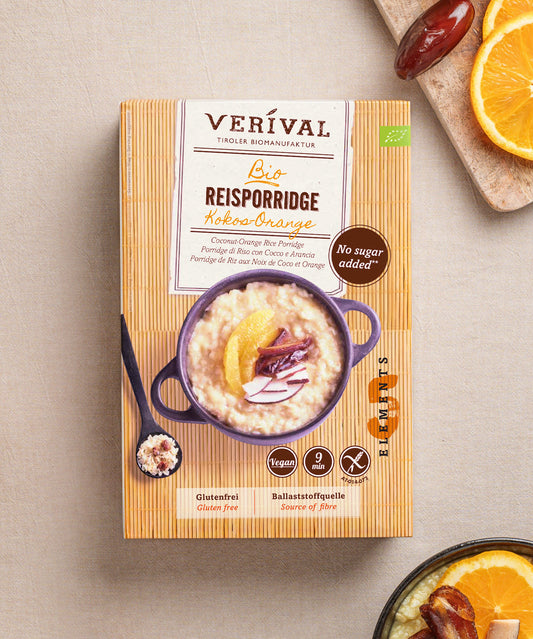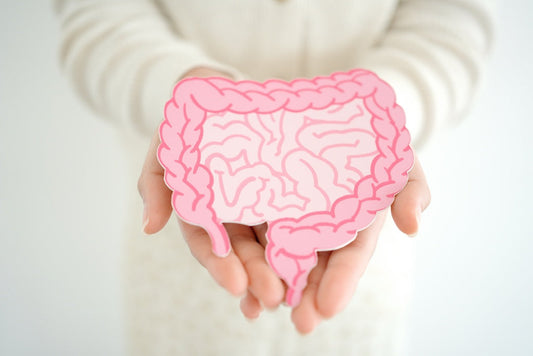If you are dealing with histamine intolerance, allergies or chronic inflammation, sooner or later you will come across a key term: mast cells. These cells play a crucial role in the immune system – they are the main storage site for histamine, the substance responsible for many symptoms. But what exactly do mast cells do in your body? Why do they sometimes overreact? And what does this mean for your diet and everyday life? In this article, you will learn what mast cells are, what role they play in histamine and how you can positively influence them through diet and lifestyle.
Verival Porridge – the classic breakfast!
What are mast cells anyway?
Mast cells are specialised immune cells that are found throughout your body – especially where your body comes into contact with the outside world: in the skin, the respiratory tract and the digestive tract. Their most important task is to react quickly to dangers and alert other defence cells. In doing so, they release a whole range of chemical messengers – primarily histamine.
Mast cells as part of the immune system
Mast cells are produced in the bone marrow and mature in the tissue. Once there, they remain in place for a long time, ready to spring into action when needed. They are mainly found at the ‘entrances’ to the body, i.e. wherever pathogens or allergens could enter: in the nose, intestines, lungs and under the skin. Their presence there is no coincidence. They act as an ‘early warning system’ and are usually the first immune cells to respond to threats.
What does histamine do in the body?
Histamine is not an ‘enemy’, but an essential messenger substance produced by your body itself. It acts in various systems and plays a central role in many biological processes. Only when it occurs in excessive amounts or is not broken down in time does it become problematic – as in the case of histamine intolerance or overactive mast cells.
Histamine as a natural regulator
Histamine is always released in the body when rapid communication is required – especially in the immune system, the gastrointestinal tract and the central nervous system. Among other things, it controls:
- Inflammatory reactions: Histamine makes blood vessels permeable so that immune cells can reach where they are needed more quickly.
- Stomach acid production: It stimulates the formation of stomach acid, which is essential for the digestion of protein.
- Neurotransmission: In the brain, histamine influences alertness, appetite and concentration.
- Allergic reactions: When it comes into contact with allergens, histamine causes typical symptoms such as itching, redness or swelling.
Why histamine can also cause symptoms
If too much histamine enters the body, the balance is upset. This happens either through a high intake of histamine-rich foods or because it is not broken down properly in the intestines. In both cases, the histamine level in the blood rises and symptoms occur.
The typical symptoms include headaches, skin reactions, breathing problems, stomach cramps or palpitations. These reactions occur because histamine acts throughout the body, not just locally. As you can see, this substance is powerful. And that is precisely why it is so important to keep it at the right level.
As soon as mast cells detect a potentially harmful signal, they release various substances within seconds that trigger or intensify inflammatory reactions. This prepares the body for battle – even if the enemy is actually harmless, as in the case of an allergic reaction.
What mast cells contain: their internal weapons
The best-known substance in mast cells is histamine. But they store many other messenger substances, such as heparin, which influences blood clotting, and various enzymes that can break down or dissolve tissue. In addition, when activated, they produce leukotrienes and prostaglandins – messenger substances that can prolong or exacerbate inflammation.
These ‘chemical chambers’ in mast cells make them extremely effective on the one hand – and dangerous on the other if they react too frequently or too strongly. This is exactly the case for many people with histamine intolerance or mast cell activation disorders.
Mast cells and histamine – how are they related?
If you want to know why histamine can cause problems in your body, you need to understand mast cells. They are the main source of histamine – they store it, control its release and thus determine how strongly your body reacts to stimuli. The connection between mast cells and histamine is the key to understanding allergies, intolerances and chronic inflammation.
The role of histamine in mast cells
Histamine does not simply lie around loose in mast cells. It is safely packaged in small vesicles called granules. These are released in a targeted manner when the cell is activated. A stimulus such as an allergen, an infection or mechanical stress can cause the mast cell to empty. The histamine is released, binds to histamine receptors in the tissue – and the body reacts immediately: with itching, swelling, redness, increased blood flow or mucus production. These are all typical reactions that you may be familiar with from hay fever, hives or food intolerance.
So histamine isn't an ‘enemy,’ but an extremely fast signalling substance – it only becomes dangerous when too much of it circulates uncontrollably in the body.
When mast cells are overactive
In many people with histamine intolerance or mast cell activation, the cells are hypersensitive. They release histamine even with minimal stimulation – and significantly more than would be necessary. The trigger can be completely harmless: a glass of red wine, tomato soup or even psychological stress. The mast cells interpret this as a danger and react with a ‘mini explosion’ of messenger substances.
What's more, if your body cannot break down histamine sufficiently – e.g. because the DAO enzyme is impaired – it remains active for too long. As a result, the body overreacts and you experience symptoms that do not correspond to a genuine allergy but feel exactly the same.
What happens when mast cells overreact?
Normally, the activation of mast cells protects you from infections and other threats. But when the reaction gets out of control, you have a problem: your body fights even though there is no real enemy. This is exactly what happens when mast cells overreact or are activated too frequently.
The vicious circle of overreaction
In people with mast cell hypersensitivity – which is common in histamine intolerance – the cells react to harmless stimuli. This can be a glass of red wine, an intense smell, heat, cold or a certain food. The mast cells then release large amounts of histamine, which leads to inflammatory reactions in the body.
Typical symptoms include itching, skin redness, breathing difficulties, diarrhoea, swelling, headaches or palpitations. The immune system is in a constant state of alert, and the body remains in reaction mode even though there is no real danger.
Why this can explain many symptoms
Overactivation of mast cells can trigger symptoms in many parts of the body at the same time. This is because mast cells are found everywhere: in the skin, intestines, lungs and brain. This explains why histamine intolerance causes such a wide range of symptoms, from skin rashes and migraines to stomach cramps.
A stimulus that goes completely unnoticed by others may trigger a whole cascade of symptoms in you. The important thing to remember is that you are not imagining the symptoms. They are real – caused by a misguided reaction of your immune system.
Discover the whole Verival breakfast range and celebrate!
What exactly is histamine intolerance?
Histamine intolerance is not a classic allergy. Your immune system does not attack foreign substances. Instead, the problem lies in the histamine metabolism itself. Your body produces or absorbs too much histamine but cannot break it down sufficiently. As a result, histamine accumulates in the body and causes symptoms that can vary greatly.
Impaired breakdown by DAO
The main cause of histamine intolerance is a deficiency or blockage of the enzyme diamine oxidase (DAO). This enzyme breaks down histamine in the intestine before it enters the bloodstream. If you have too little DAO or if it is inhibited by medication, stress, inflammation or certain foods, histamine remains active for too long – and you react with symptoms.
This also explains why many sufferers seem to suddenly react to certain foods that they used to tolerate without any problems. In most cases, DAO activity has already been reduced over a long period of time – until the histamine level eventually becomes too high.
Why diagnosis is often difficult
Histamine intolerance cannot be easily detected by a standard blood test. There are no clear markers as there are with allergies. The symptoms are varied, occur with a delay and are often confused with other conditions: irritable bowel syndrome, migraine, neurodermatitis or food allergies.
That is why it is so important to observe your body. A food diary, a targeted low-histamine diet and, ideally, medical supervision will help you gain certainty. If your symptoms improve with a low-histamine diet, this is often the clearest confirmation.
Histamine intolerance: symptoms and causes
Histamine intolerance manifests itself differently in each person. Some get headaches, others suffer from digestive problems or rashes. This makes the intolerance so difficult to recognise – it has many faces. But the cause is usually the same: too much histamine in the body that is not broken down quickly enough.
The most common symptoms at a glance
If you regularly experience discomfort after eating – and no classic allergy has been diagnosed – it is worth taking a closer look at the typical symptoms of histamine intolerance:
- Skin: itching, hives, redness or welts – especially on the face, neck or décolleté
- Digestion: flatulence, abdominal cramps, diarrhoea or nausea, often shortly after eating
- Circulation: dizziness, palpitations, sudden drop in blood pressure or inner restlessness
- Head and nervous system: tension headaches or migraines, sleep disturbances, irritability
- Respiratory tract: stuffy nose, sneezing, shortness of breath or coughing (even without allergies)
These symptoms occur particularly frequently after consuming foods rich in histamine, such as red wine, mature cheese, chocolate or tomatoes – but sometimes also without any apparent trigger.
Why the causes can be varied
The most common cause of histamine intolerance is a deficiency of diamine oxidase (DAO) – the enzyme that breaks down histamine in the intestine. However, other factors can also play a role:
- Chronic intestinal diseases: such as irritable bowel syndrome or leaky gut syndrome impair DAO production.
- Medications: painkillers, antidepressants or antibiotics can block DAO or destabilise mast cells.
- Stress: increases the release of histamine in the body and often worsens digestion.
- Hormonal changes: e.g. during pregnancy or menstruation, can exacerbate symptoms.
As you can see, histamine intolerance is not a simple reaction, but a complex interplay of diet, gut health, stress and hormonal balance.
How to easily incorporate low-histamine meals into your everyday life
A low-histamine diet may sound restrictive at first, but it is easy to follow if you stick to a few basic principles. It is not only important what you eat, but also how fresh your food is and how you store it. You don't have to completely change your daily routine, but you do need to be more conscious of what you eat.
Fresh, simple and well prepared
Avoid ready-made products, highly processed foods and anything that has been stored for a long time. Histamine forms during ripening, fermentation and long storage – even in the fridge. Therefore, cook fresh, buy small quantities and freeze leftovers rather than keeping them.
You don't have to cook elaborate meals. Simple combinations of rice, millet, fresh vegetables such as courgettes or carrots and mild proteins such as chicken or fresh fish are easy to digest – if you prepare them straight away. These dishes also taste good cold, making them ideal for the office or on the go.
Security through recurring routines
Start with a small repertoire of meals that you tolerate well and can prepare quickly. Breakfast, lunch and dinner don't have to be different every day. Once you've found a few favourite dishes, you'll develop a routine, gain confidence and feel more relaxed. This will take the strain off your body – and your mind.
The best recipes for the perfect low-histamine breakfast
In the morning, you need something that fills you up, keeps your blood sugar stable and doesn't put any additional strain on your histamine levels. Many classic breakfast foods such as cheese, sausage, wheat rolls and fruit juices are not suitable for people with histamine intolerance. Fortunately, there are simple alternatives that are easy to prepare and don't taste boring.
Millet porridge with pear and cinnamon
Ingredients:
- 60 g millet flakes
- 200 ml rice milk or water
- 1 small ripe pear (grated)
- ½ teaspoon Ceylon cinnamon
- 1 teaspoon coconut oil
Preparation
Bring the millet flakes, rice milk and pear to the boil, then simmer on a low heat for 5–8 minutes. Finally, stir in the cinnamon and coconut oil. The result is a warming, easily digestible breakfast that you can also take with you.
Oat bowl with blueberries and flax seeds
Ingredients:
- 50 g gluten-free oat flakes
- 150 ml oat milk (without additives)
- 1 handful of fresh or frozen blueberries
- 1 teaspoon flaxseed (ground)
- 1 teaspoon rice syrup
Preparation:
Put everything in a bowl and leave to stand for 10 minutes – or prepare overnight in the fridge. The blueberries provide freshness, the flaxseed provides healthy fibre – and the whole thing is mild and filling.
Discover our healthy Verival snacks here!
Conclusion: Mast cells as histamine stores
Mast cells are the guardians of your immune system – and also the main players when it comes to histamine reactions. They react to external stimuli, store large amounts of histamine and can trigger a cascade of symptoms if they overreact. If your body cannot break down histamine, an imbalance develops that affects many areas of your well-being.
If you understand the role of mast cells, you can take targeted countermeasures – with a low-histamine diet, fresh foods, targeted stress reduction and awareness of your own body. Step by step, you will develop a sense of what is good for you – and find your way back to a better quality of life, more energy and inner peace.

